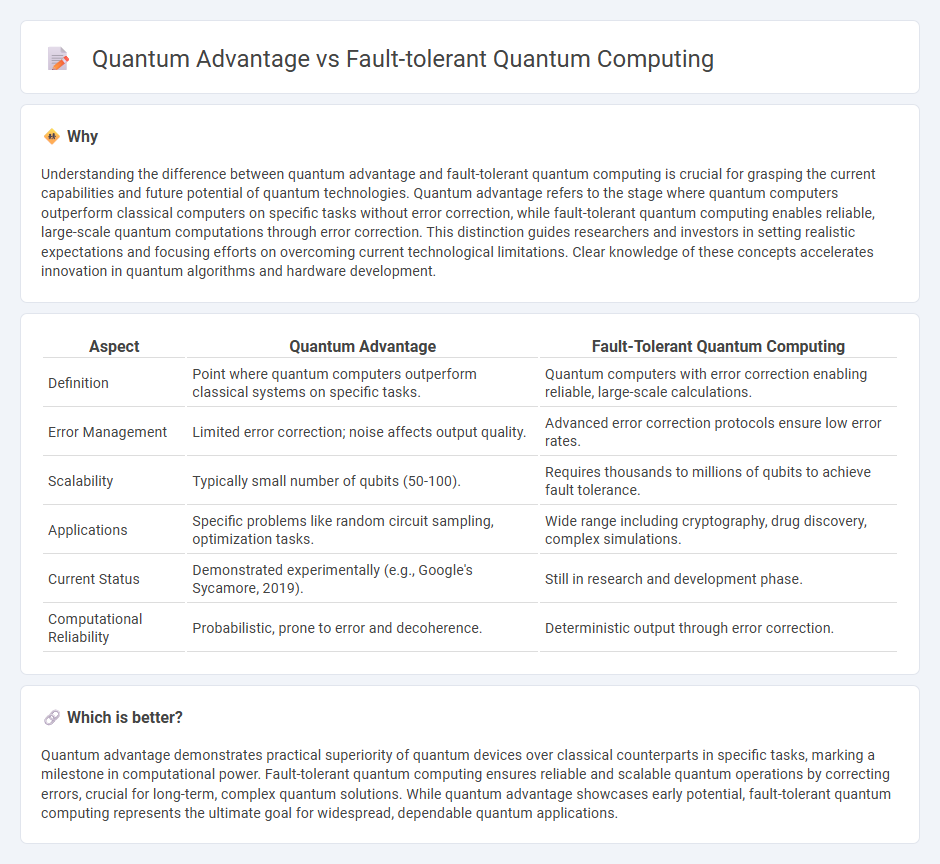
Quantum advantage refers to the point where quantum computers outperform classical counterparts on specific tasks using near-term, noisy devices without error correction. Fault-tolerant quantum computing involves implementing robust error-correcting codes to enable long, reliable quantum computations despite qubit errors. Explore the nuances of these breakthrough approaches to understand the future of quantum technology.
Why it is important
Understanding the difference between quantum advantage and fault-tolerant quantum computing is crucial for grasping the current capabilities and future potential of quantum technologies. Quantum advantage refers to the stage where quantum computers outperform classical computers on specific tasks without error correction, while fault-tolerant quantum computing enables reliable, large-scale quantum computations through error correction. This distinction guides researchers and investors in setting realistic expectations and focusing efforts on overcoming current technological limitations. Clear knowledge of these concepts accelerates innovation in quantum algorithms and hardware development.
Comparison Table
| Aspect | Quantum Advantage | Fault-Tolerant Quantum Computing |
|---|---|---|
| Definition | Point where quantum computers outperform classical systems on specific tasks. | Quantum computers with error correction enabling reliable, large-scale calculations. |
| Error Management | Limited error correction; noise affects output quality. | Advanced error correction protocols ensure low error rates. |
| Scalability | Typically small number of qubits (50-100). | Requires thousands to millions of qubits to achieve fault tolerance. |
| Applications | Specific problems like random circuit sampling, optimization tasks. | Wide range including cryptography, drug discovery, complex simulations. |
| Current Status | Demonstrated experimentally (e.g., Google's Sycamore, 2019). | Still in research and development phase. |
| Computational Reliability | Probabilistic, prone to error and decoherence. | Deterministic output through error correction. |
Which is better?
Quantum advantage demonstrates practical superiority of quantum devices over classical counterparts in specific tasks, marking a milestone in computational power. Fault-tolerant quantum computing ensures reliable and scalable quantum operations by correcting errors, crucial for long-term, complex quantum solutions. While quantum advantage showcases early potential, fault-tolerant quantum computing represents the ultimate goal for widespread, dependable quantum applications.
Connection
Quantum advantage refers to a quantum computer performing a specific task faster or more efficiently than classical counterparts, demonstrating practical superiority. Fault-tolerant quantum computing is crucial to achieving quantum advantage by enabling reliable computation despite errors, using error correction methods. The connection lies in fault tolerance providing the stability necessary for quantum systems to consistently exhibit quantum advantage in real-world applications.
Key Terms
**Fault-tolerant quantum computing:**
Fault-tolerant quantum computing ensures reliable operation of quantum systems by correcting errors through error-correcting codes and fault-tolerant protocols, enabling scalable quantum algorithms on noisy hardware. It addresses physical qubit imperfections and decoherence, paving the way for executing complex quantum computations exponentially faster than classical counterparts. Explore how fault-tolerant methods unlock the full potential of quantum technology and surpass quantum advantage benchmarks.
Quantum Error Correction
Quantum Error Correction (QEC) is essential for fault-tolerant quantum computing, enabling qubits to resist errors from decoherence and operational noise by encoding logical qubits across multiple physical qubits. In contrast, achieving quantum advantage involves demonstrating computational tasks where quantum processors outperform classical ones, often without fully implementing QEC. Explore the critical role of QEC techniques and their impact on realizing scalable, reliable quantum computers.
Logical Qubit
Fault-tolerant quantum computing relies on logical qubits, which are encoded from multiple physical qubits using error-correcting codes to protect quantum information from decoherence and operational errors. Quantum advantage refers to the demonstration that a quantum computer can solve a specific problem more efficiently than any classical computer, often achievable with noisy intermediate-scale quantum (NISQ) devices that do not yet employ error correction. Explore deeper insights into the role of logical qubits in bridging near-term quantum advantage to scalable, fault-tolerant quantum computation.
Source and External Links
Understanding Fault Tolerant Quantum Computing - Part I - Fault-tolerant quantum computing relies on Quantum Error Correction (QEC) to prevent the spread of inevitable local errors through the system, allowing computations to proceed correctly even when some components fail.
What is fault-tolerant quantum computing? - IBM - A fault-tolerant quantum computer is designed to operate accurately despite errors, using real-time detection and correction to manage the sensitivity of qubits to environmental noise and decoherence, enabling larger and more complex quantum circuits.
What is Fault-tolerant Computing - Fault-tolerant quantum computing employs techniques like redundancy, Quantum Error Correction Codes (QECC), and fault-tolerant gate sets to ensure continued correct operation even when errors occur, with ongoing research into more resilient qubits and error mitigation strategies.
 dowidth.com
dowidth.com